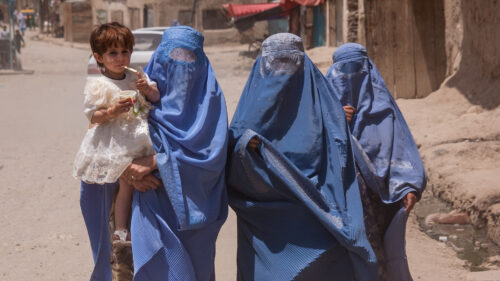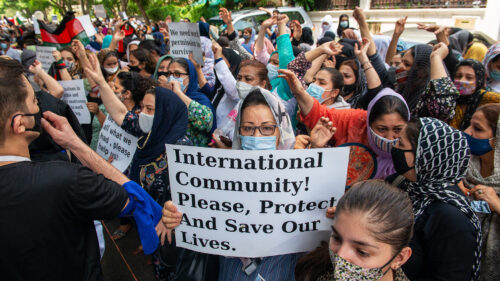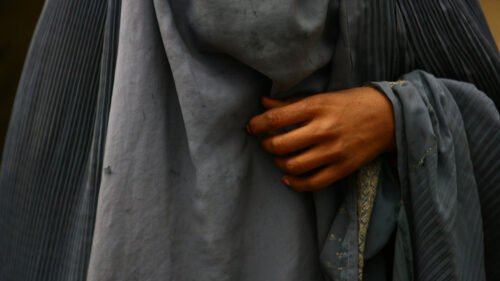Since the Taliban returned to power in Afghanistan in 2021, women’s rights have been severely rolled back. The Taliban has drastically curtailed women’s education, revoked their public roles and suppressed even their basic freedom to travel unaccompanied. And despite global condemnation of this abuse, meaningful support for Afghan women has remained elusive. This forces them to fight their battle in near isolation.
Yet even under such oppressive conditions, Afghan women refuse to go down quietly. Instead, they find courageous and inventive ways to resist, and offer hope to future generations of not only Afghan women, but all women. Their struggle is not merely an isolated regional issue — it embodies the fight for women’s rights under authoritarian regimes everywhere.
Taliban restrictions and secret schools
The fundamentalist Taliban regime has systematically and wholly dismantled the hard-won rights of women. Since the 2021 takeover, the status of Afghan women’s rights has regressed to that of pre-2002 conditions — when the Taliban last dominated the country. Two decades of human rights progress were erased overnight.
By early 2023, the Taliban had banned girls from secondary schools and universities, which stripped 1.1 million young women of formal education. The regime also barred women from most kinds of employment, except in highly restricted sectors such as healthcare. The social and economic consequences of these policy impositions have devastated families and pushed them — and especially young women — further into poverty and deprivation.
But Afghan women have responded to these injustices with courage and determination. They refuse to be silenced.
Against Taliban bans, secret schools have become some of the most potent symbols of women’s defiance. These undercover classrooms are run by volunteer teachers who educate Afghan girls at the risk of severe punishment. These covert education efforts operate in civilian homes and hidden locations. They teach math, science and literature, and they are under constant threat of Taliban surveillance. For many girls, these makeshift schools represent not just opportunities for education but also a reminder of their inalienable rights to learn and shape their futures.
“Every time I walk to class, I fear I may be caught,” said one such student, who attends an underground school in Kabul. “If my education is a crime, it is worth the risk.”
“We [tell them] that they are not alone.”
Education is not the only front where Afghan women are fighting back. In a further show of resistance, women have begun to lead media initiatives — like Radio Femme, a station dedicated to educating Afghan women and advocating for their rights — to empower those subjugated. Broadcasting in Pashto and Dari, Afghanistan’s two official languages, Radio Femme provides critical information on health, education and women’s legal rights. Despite operating under severe restrictions, the station provides Afghan women with invaluable knowledge and a sense of solidarity in an environment where their access to information and community has been systematically cut off.
“Our listeners are women who feel isolated and forgotten. We give them information but also the message that they are not alone,” said Hawa, a former teacher who founded the station. The women behind Radio Femme face harassment and threats, yet they persist in their vital work. They have no other option under the brutal Taliban regime.
Social media has become a key means for Afghan women to amplify their voices and share their stories with the world. They leverage platforms like X and Instagram to expose abuses, organize protests and connect with global supporters. Their digital resistance has effectively raised awareness, but it comes with significant perils.
Online harassment, gendered hate speech and even death threats have become commonplace dealings for Afghan women activists. Within the first year of the Taliban’s return, the Centre for Information Resilience reported a threefold increase in online abuse targeting politically engaged Afghan women. These women live with an ever-present sense of danger — but they refuse to stop fighting.
Beyond the digital sphere, Afghan women have also begun to defy the Taliban’s tyranny through artistic mediums such as art, poetry and photography. Some artists challenge the erasure of women from public life, while others honor the memories of those who have suffered from or been lost to violence and oppression.
Atena, a 23-year-old artist from Herat, paints murals of Afghan women in traditional clothing. “Through my art,” she explains, “I show the world that we exist and that we are more than victims.”
Global solidarity and our responsibility
Afghan women continue to resist oppression, but they cannot fight alone. The international community must act, regardless of past setbacks in dealing with the Taliban. Since the Taliban’s return, the United Nations has delivered $2.9 billion in humanitarian aid to Afghanistan, with the United States among the key contributors. However, reports reveal that much of this aid has been diverted into Taliban hands — it offers little relief to Afghan women.
The rollback of US aid programs has only worsened conditions for Afghan women. With the dismantling of USAID, efforts like secret schools, independent media such as Zan Times, and women-led initiatives are now at risk of disappearing entirely.
Individuals and organizations worldwide must push back against policies that threaten Afghan women’s survival, including the dismantling of USAID. Advocacy groups like UN Women, Women for Afghan Women and RAWA are crucial in ensuring resources reach grassroots efforts that provide education, shelter and healthcare. Public pressure is equally critical — urging policymakers to protect existing aid programs, prioritize Afghan women in refugee resettlement and enforce stricter oversight can help prevent further harm.
International aid must come with clear conditions. Funding should be redirected to underground schools, women-led initiatives and verified humanitarian efforts rather than flowing into Taliban-controlled channels. The elimination of USAID programs demands an urgent response to prevent the collapse of crucial support systems.
Policymakers respond to public pressure, diplomatic leverage and media scrutiny. Ensuring aid reaches those who need it most requires legal accountability, strategic funding and unwavering advocacy. Without these safeguards, Afghan women will continue to be systematically excluded from the very assistance meant to protect them.
[India Nye Wenner and Lee Thompson-Kolar edited this piece.]
The views expressed in this article are the author’s own and do not necessarily reflect Fair Observer’s editorial policy.
Support Fair Observer
We rely on your support for our independence, diversity and quality.
For more than 10 years, Fair Observer has been free, fair and independent. No billionaire owns us, no advertisers control us. We are a reader-supported nonprofit. Unlike many other publications, we keep our content free for readers regardless of where they live or whether they can afford to pay. We have no paywalls and no ads.
In the post-truth era of fake news, echo chambers and filter bubbles, we publish a plurality of perspectives from around the world. Anyone can publish with us, but everyone goes through a rigorous editorial process. So, you get fact-checked, well-reasoned content instead of noise.
We publish 3,000+ voices from 90+ countries. We also conduct education and training programs
on subjects ranging from digital media and journalism to writing and critical thinking. This
doesn’t come cheap. Servers, editors, trainers and web developers cost
money.
Please consider supporting us on a regular basis as a recurring donor or a
sustaining member.
Will you support FO’s journalism?
We rely on your support for our independence, diversity and quality.








Comment